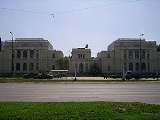
National Museum of Bosnia and Herzegovina
Encyclopedia
The National Museum of Bosnia and Herzegovina (Zemaljski Muzej Bosne i Hercegovine) is located in central Sarajevo
, the capital of Bosnia and Herzegovina
. It was established in 1888, having originally been conceived around 1850. In 1913, the museum was enlarged by the Czech architect Karel Pařík who designed a structure of four symmetric pavilions
with a facade in Italian Renaissance style. The four pavilions contain the departments of archaeology, ethnology, natural history, and a library. After being closed for several years due to heavy damage in the recent war, the museum has re-opened and is in the process of mounting new and pre-existing exhibits.
The museum is a cultural and scientific institution covering a wide range of areas including archaeology
, art history
, ethnology
, geography
, history
and natural history
. The Sarajevo Haggadah
, an illuminated manuscript
and the oldest Sephardic Jewish document in the world issued in Barcelona
around 1350, containing the traditional Jewish Haggadah, is held at the museum.
Sarajevo
Sarajevo |Bosnia]], surrounded by the Dinaric Alps and situated along the Miljacka River in the heart of Southeastern Europe and the Balkans....
, the capital of Bosnia and Herzegovina
Bosnia and Herzegovina
Bosnia and Herzegovina , sometimes called Bosnia-Herzegovina or simply Bosnia, is a country in Southern Europe, on the Balkan Peninsula. Bordered by Croatia to the north, west and south, Serbia to the east, and Montenegro to the southeast, Bosnia and Herzegovina is almost landlocked, except for the...
. It was established in 1888, having originally been conceived around 1850. In 1913, the museum was enlarged by the Czech architect Karel Pařík who designed a structure of four symmetric pavilions
Pavilion (structure)
In architecture a pavilion has two main meanings.-Free-standing structure:Pavilion may refer to a free-standing structure sited a short distance from a main residence, whose architecture makes it an object of pleasure. Large or small, there is usually a connection with relaxation and pleasure in...
with a facade in Italian Renaissance style. The four pavilions contain the departments of archaeology, ethnology, natural history, and a library. After being closed for several years due to heavy damage in the recent war, the museum has re-opened and is in the process of mounting new and pre-existing exhibits.
The museum is a cultural and scientific institution covering a wide range of areas including archaeology
Archaeology
Archaeology, or archeology , is the study of human society, primarily through the recovery and analysis of the material culture and environmental data that they have left behind, which includes artifacts, architecture, biofacts and cultural landscapes...
, art history
Art history
Art history has historically been understood as the academic study of objects of art in their historical development and stylistic contexts, i.e. genre, design, format, and style...
, ethnology
Ethnology
Ethnology is the branch of anthropology that compares and analyzes the origins, distribution, technology, religion, language, and social structure of the ethnic, racial, and/or national divisions of humanity.-Scientific discipline:Compared to ethnography, the study of single groups through direct...
, geography
Geography
Geography is the science that studies the lands, features, inhabitants, and phenomena of Earth. A literal translation would be "to describe or write about the Earth". The first person to use the word "geography" was Eratosthenes...
, history
History
History is the discovery, collection, organization, and presentation of information about past events. History can also mean the period of time after writing was invented. Scholars who write about history are called historians...
and natural history
Natural history
Natural history is the scientific research of plants or animals, leaning more towards observational rather than experimental methods of study, and encompasses more research published in magazines than in academic journals. Grouped among the natural sciences, natural history is the systematic study...
. The Sarajevo Haggadah
Sarajevo Haggadah
The Sarajevo Haggadah is an illuminated manuscript that contains the illustrated traditional text of the Passover Haggadah which accompanies the Passover Seder. It is one of the oldest Sephardic Haggadahs in the world, originating in Barcelona around 1350. The Haggadah is presently owned by the...
, an illuminated manuscript
Illuminated manuscript
An illuminated manuscript is a manuscript in which the text is supplemented by the addition of decoration, such as decorated initials, borders and miniature illustrations...
and the oldest Sephardic Jewish document in the world issued in Barcelona
Barcelona
Barcelona is the second largest city in Spain after Madrid, and the capital of Catalonia, with a population of 1,621,537 within its administrative limits on a land area of...
around 1350, containing the traditional Jewish Haggadah, is held at the museum.

